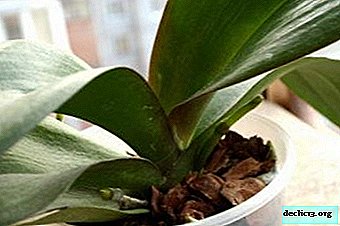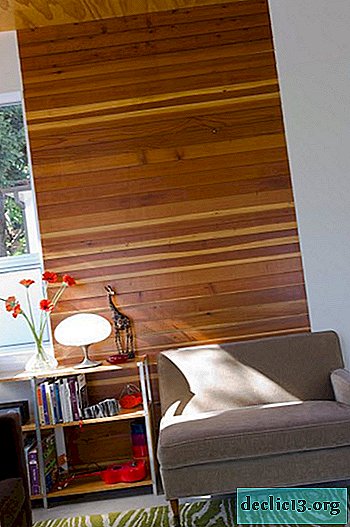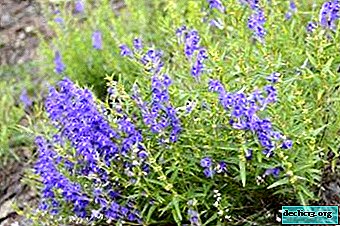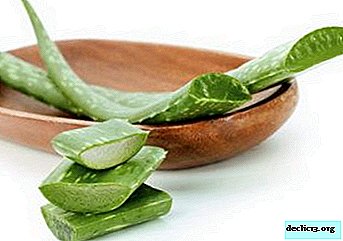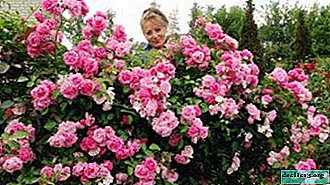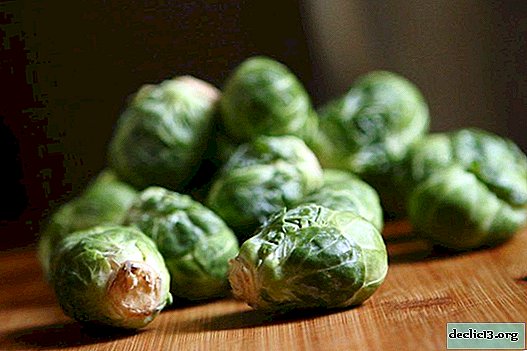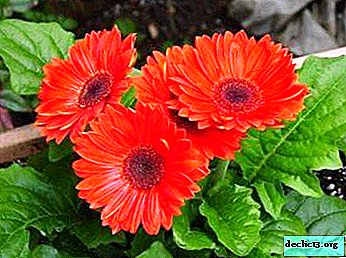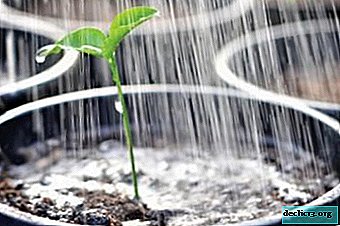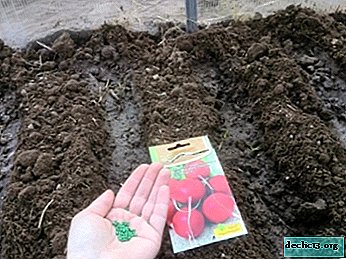Green carpet in a pot: how to use moss for orchids?
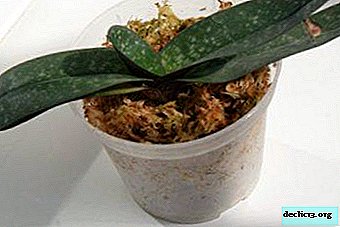
Caution should be taken when adding each new ingredient to an orchid pot. These tropical beauties can ruin even minor changes.
Much attention is paid to moss for orchids. Some flower growers consider a green carpet in a pot an indispensable tool, a lifesaver. Others are sure: from the moss, the orchid dies. How is things really going? We will cover all of this in detail in our article. Also watch a helpful video on the topic.
What it is?
Moss is a creeping (less often upright plant), lacking roots and flowers. Grows in damp places:
- wet ground;
- rotting tree trunks;
- stones by the water.
The etymology of the word "moss" comes from the Greek "sphagnum", i.e. "sponge". According to the scheme of action, this plant really resembles a sponge. It can absorb the amount of water that is 20 times its own weight! Then gradually moisture is given to those plants that grow on moss. It would seem - for orchids that love high humidity, there is nothing better.
Moss Functions:
- active absorption of water;
- moisture preservation for several days;
- uniform moistening of the soil (moss covers it completely);
- preservation of plant roots from rotting (due to the sphagnol substance contained in moss, which has antibacterial properties).
What is it needed for?
Moss is used in orchid cultivation for a variety of purposes.. It can be used as:
- Independent substrate.
- Useful supplement.
It is used for such purposes:
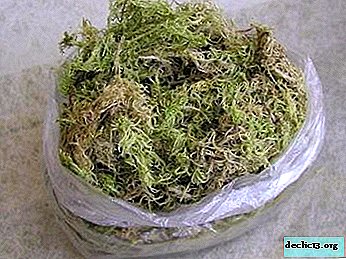 As a coating layer, to increase humidity and prevent the rapid drying of the main substrate (how to choose a substrate for orchids?). Watering remains the same, but moisture due to moss increases.
As a coating layer, to increase humidity and prevent the rapid drying of the main substrate (how to choose a substrate for orchids?). Watering remains the same, but moisture due to moss increases.- As a means to get kids with a peduncle (only works with phalaenopsis). It is necessary to cut off the peduncle, spread it with cytokinin paste and place in a container with wet moss. The container is periodically ventilated. Gradually, a sleeping kidney will wake up and a baby will start to grow from it.
- As a substrate for growing children. You can put the separated orchid seedlings in clean moss. Watering in this case is minimal, with complete drying. Also, for children, moss and bark are mixed: then the watering remains the same, but a couple of days you need to keep the soil dry.
- For resuscitation of dying orchids. If the plant has completely rotted the roots, you can plant it in sphagnum (sometimes even living moss is taken for this purpose) as a substrate and provide greenhouse conditions. Very often this allows you to save the plant.
- As a means for rooting roots to the block (some orchids grow only if you plant them on an imitation of a tree branch or rock). Moss is planted under the roots to fix them on the block. In this case, you can not do without problems: the first six months, the access of moisture and air will be optimal. But then the growth of algae and the formation of salt sediment is inevitable. This phase just needs to endure. Then the sphagnum will crumble and, after about a year, it will not be - but the plant will be firmly attached to the block for a long time.
- As a mixture with bark during the period of active root growth. The surface of the substrate is covered with moss so that the young roots do not dry out. In this case, the following rule is observed: the more perforation (holes in the pot), the more moss is required.
Advantages and disadvantages
So, proper use of moss can help with many problems. The pluses include:
- long-term preservation of humidity (even if your house is hot and dry);
- indispensable help with the growth of young or weakened plants;
- disinfecting properties (orchids with sphagnum moss in a pot are less likely to get sick);
- esthetic appearance: moss on the surface of the pot (especially if it is alive), looks very nice, but a block with blooming orchid and lush green moss in general at the first glance is able to transport you to the tropics.
But among inexperienced gardeners, a moss-covered plant often dies.. There are such disadvantages:
- with moss it is easy to “overdo it”, laying it in a thick thick layer, you are almost guaranteed to block access to the roots and destroy the plant;
- moss in a pot contributes to rotting of the roots; proper watering with moss is more difficult to calculate;
- if the moss was not properly harvested, pests will start in it, which will quickly destroy your orchid;
- due to moss, the soil may become saline and algae form on it.
The plant will take root in the moss or not - depends on many factors:
- watering frequency;
- humidity;
- specific watering temperature.
Varieties
Sphagnum

The most common moss is sphagnum. It grows mainly in the Northern Hemisphere, in the South it can be found only in the mountains. Most often, sphagnum is found in coniferous forests, on slightly boggy soils and outright swamps. A large mass appears on the upper bogs - there it covers the entire surface like a pillow. From a distance it looks like a luxurious green carpet, which is often deceived by inexperienced tourists.
It is curious that subsequently horse peat is formed from dead sphagnum, which is also an indispensable component of the substrate, only for terrestrial rather than epiphytic orchids.
Sphagnum is a soft thin stems, it is gentle to the touch. Because of the color, this moss is also sometimes called "white." The leaves are needle-like, sticking out in all directions. The dead parts of the plant contain a lot of water.
When collecting this moss is extremely easy to take out. Use it for orchids and as a substrate, and as a cover for the soil and even as a disinfectant. Its disinfecting, antibacterial properties are so great that they are used even in medicine!
Reindeer moss

Yagel, as it is also called, Icelandic or deer moss, contrary to the name, grows in a variety of climatic regions, from warm to the polar tundra. This is a species of lichen covering the ground. It is very dense, gray in color.
Jagel is a great option for those who are wondering how to replace sphagnumwhen it does not grow nearby. After all, this moss can be either collected independently or bought - most often the moss is sold in phytodesign stores. Healing tea is also made from it, so Icelandic moss can be found in medicinal herbs. The disadvantage of reindeer moss is that it is brittle and crumbles easily. But some gardeners still use it as drainage inside another, softer moss.
Kukushkin flax

Kukushkin flax, or, as it is also called, forest moss, grows abundantly in the forest, in clearings and around tree trunks. Often alternates with sphagnum, so that from one glade you can collect two types of moss at once. Its upper part is green, and the lower part is brown, it is vaguely reminiscent of a juniper branch. It compares favorably with the previous two varieties of moss in that:
- does not crumble upon drying;
- does not retain moisture for a long time;
- pests are immediately visible in it, they are easy to remove.
Kukushkin flax is used as the main substrate or as an addition to it. It is irreplaceable when growing plants on the block and equitants: they will not rot, and besides, the moss will not crumble quickly.
Collect or buy?
If we are talking about the ordinary sphagnum, it is better to collect it. It grows abundantly in the forest. Having assembled it yourself, you will be sure of the quality of the product, that there are no pests in it, and also save a little. The same goes for cuckoo flax. But it’s necessary to look for the reindeer moss, it does not grow everywhere. So, in order not to run through the forest in vain, it is better to purchase it.
IMPORTANT: Cutting off the moss, do not touch the lower part of the plant, only the top can be torn off. Otherwise, there will be nothing to form for new shoots, and next year you will find a black spot in the place of a mossy meadow.It’s easy to buy moss for orchids: almost all flower shops provide this service.. You can order exotic moss from the homeland of orchids on the Internet, it will come to you, packed in special packages.
Processing, disinfection and drying
When harvesting moss, it is worth remembering that various harmful microorganisms perfectly reproduce in it. If you just collect it in the forest and put it in a pot, then soon there will be bugs, pests and even possibly snails. So, having collected the moss, be sure to process it. Rinse thoroughly with boiling water, disassemble into separate twigs. Then you can apply one of the processing methods:
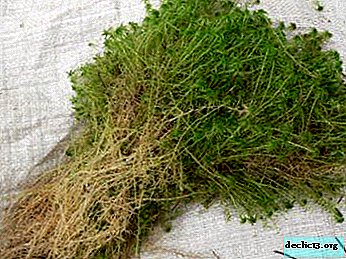 Soak the moss in warm water for about 12 hours. Remove, treat with “Acarin” and hold for about 2 weeks, periodically rinsing with water from above. After that, lay the blank to dry in a sunny place. Under the influence of sunlight, the insecticide breaks up into parts and evaporates.
Soak the moss in warm water for about 12 hours. Remove, treat with “Acarin” and hold for about 2 weeks, periodically rinsing with water from above. After that, lay the blank to dry in a sunny place. Under the influence of sunlight, the insecticide breaks up into parts and evaporates.- A faster option is to pour boiled water over the collected moss for 3-5 minutes, then squeeze it slightly and put it out to dry on the windowsill. Despite the simplicity of this method, there will be no insects left after drying - they will scatter.
If no sunny weather is foreseen, it is raining outside, then the moss can be gathered in small bunches and hung to dry on a rope. And here in the oven or in a special dryer, it is better not to dry the moss: so it does not dry out to the end.
How to use sphagnum?
Let's talk about the rules for planting orchids in substrates with the addition of moss:
- As an additive, moss can be put in the pot in cases where the top of the soil dries quickly, and you see that the roots on the surface dry out. If the flower grows in a basket, you should cover it with moss from all sides. Follow these guidelines:
- moss can not be placed close to the neck of the orchid and rammed tightly - this leads to decay;
- moss thickness should not exceed 3-4 cm.
- Ground moss is added to the inside of the substrate. In this case, it must first be treated with mineral fertilizer, for example, Kemira Lux. Then the sphagnum is ground and added to the mixture. For example, such a composition: ground moss, ground fern leaves, pieces of bark, crushed charcoal. This mixture is sprinkled under the roots, and not put up.
- You can make the mixture a little differently: moss and bark are stacked in layers in a pot. The bottom layer is the bark (in more detail about which bark can be used for orchids and how you can prepare it with your own hands, find out here).
- Experienced gardeners grow the plant and just in the moss. In this case, an orchid is set in peas, the gaps between the roots are not tightly filled with moss. Drainage is mandatory at the bottom.
You can find out more about the optimal soil composition for orchids and how to cook it yourself, here.
TIP: If the moss is too dry, it will be inconvenient to work with it. His scales fly into his eyes, nose and clothes. It can be moistened with a spray gun. Or, the night before use, put the right amount of moss in a plastic bag, pour a small amount of water there and tie a bag. By morning, moss will gain the necessary elasticity.Watch the video on the use of sphagnum moss for orchids:
What to do when you appear in the pot yourself?
 Sometimes in a pot of orchids (usually between May and August) a green bloom appears. This plaque is nothing but self-growing moss or algae. By themselves, they do not represent a danger to the flower. But the appearance in the pot of green moss or a touch of algae indicates that the pot is too damp: for their development, dampness and heat are needed.
Sometimes in a pot of orchids (usually between May and August) a green bloom appears. This plaque is nothing but self-growing moss or algae. By themselves, they do not represent a danger to the flower. But the appearance in the pot of green moss or a touch of algae indicates that the pot is too damp: for their development, dampness and heat are needed.
In addition to excess watering, this can occur when the pot is too large or the substrate has caked. In this situation, the orchid needs to be transplanted:
- rinse and dry the roots;
- take a new substrate;
- rinse the pot with alcohol and dry.
Watering after transplanting is reduced.
Use problems
The most common problem is soil salting. Sphagnum takes a lot of water and quickly evaporates it from the surface - because of this, the problem arises even with distilled water. The problem will be visible to the eye, in addition, the leaves of the orchid will turn yellow. Moss salinization can also occur on the block. In this situation, the moss needs to be changed (sometimes the plant is completely transplanted). Orchid leaves are washed with liquid fertilizer.
TIP: Lay moss with palm or coconut fiber. Less salt is deposited on it and algae grows.Sometimes a plant with moss does not take root. In this case, it can be replaced with the same coconut fiber. Some for the same purpose use the most common wet wipes (but the risk of decay is even greater) or dry small clay balls.
Conclusion
Use moss or not - it's up to you. In any case, with careful care and regular watering, the orchid will grow perfectly with both moss and without it, and will thank you with luxurious flowers and lush greenery.

 As a coating layer, to increase humidity and prevent the rapid drying of the main substrate (how to choose a substrate for orchids?). Watering remains the same, but moisture due to moss increases.
As a coating layer, to increase humidity and prevent the rapid drying of the main substrate (how to choose a substrate for orchids?). Watering remains the same, but moisture due to moss increases. Soak the moss in warm water for about 12 hours. Remove, treat with “Acarin” and hold for about 2 weeks, periodically rinsing with water from above. After that, lay the blank to dry in a sunny place. Under the influence of sunlight, the insecticide breaks up into parts and evaporates.
Soak the moss in warm water for about 12 hours. Remove, treat with “Acarin” and hold for about 2 weeks, periodically rinsing with water from above. After that, lay the blank to dry in a sunny place. Under the influence of sunlight, the insecticide breaks up into parts and evaporates.